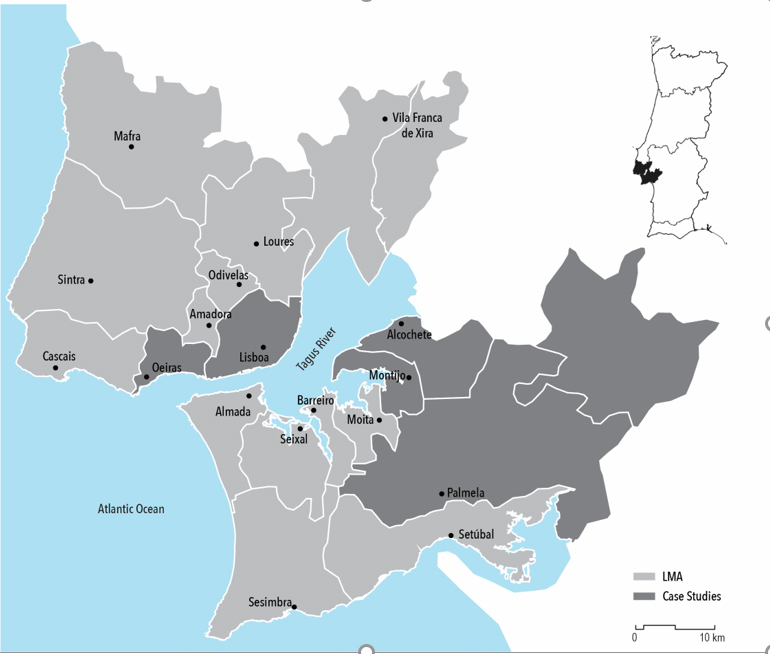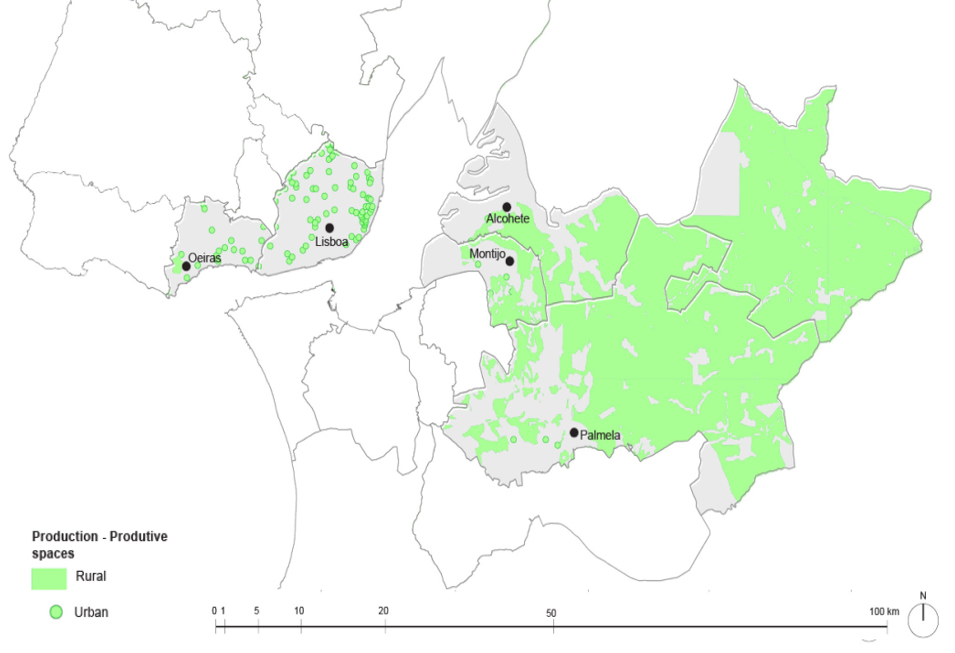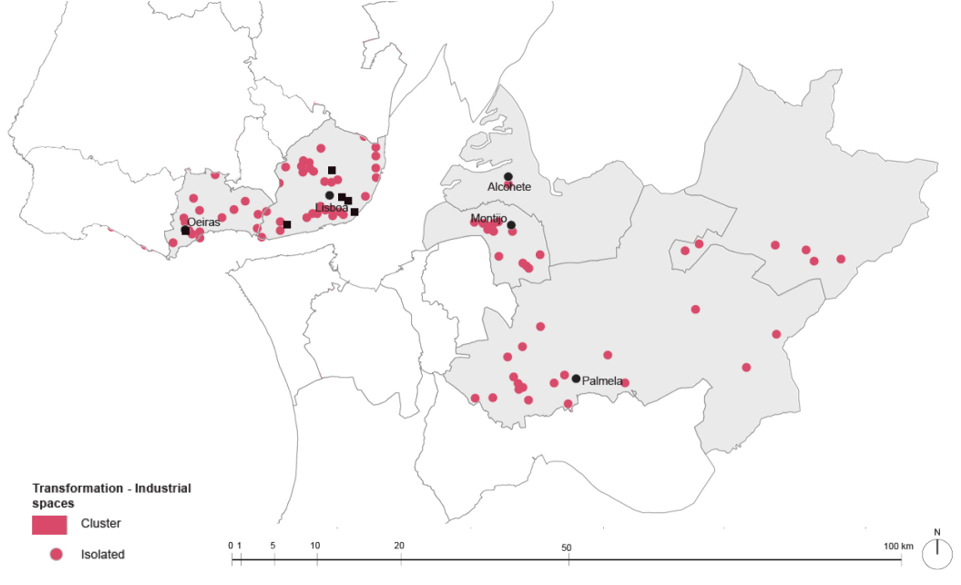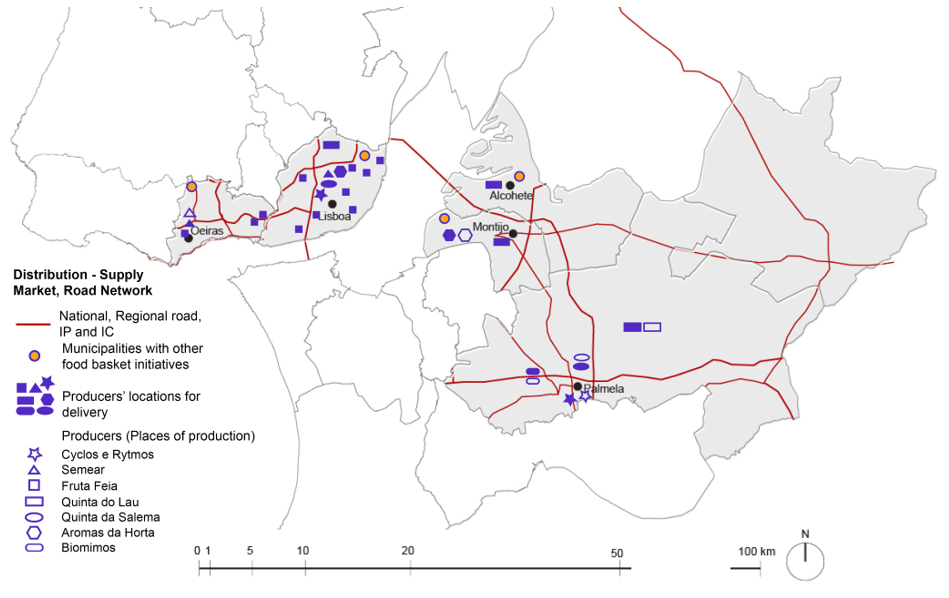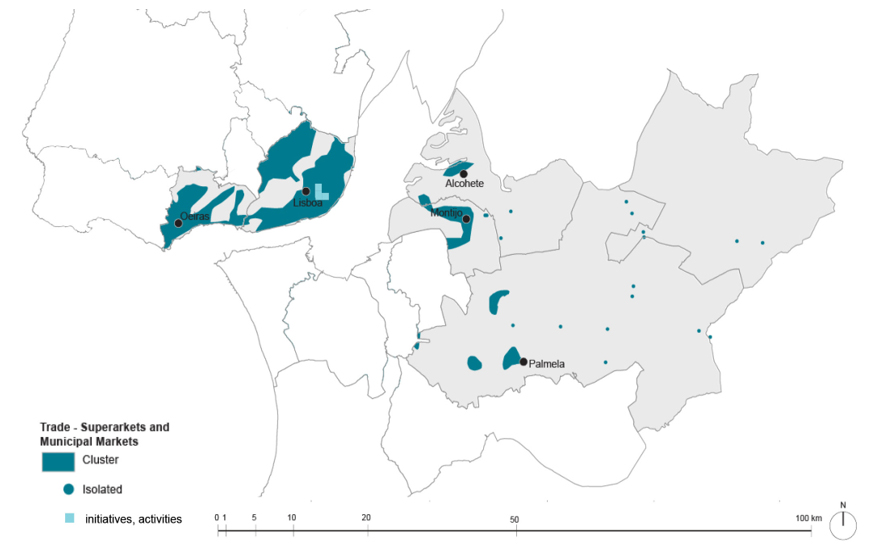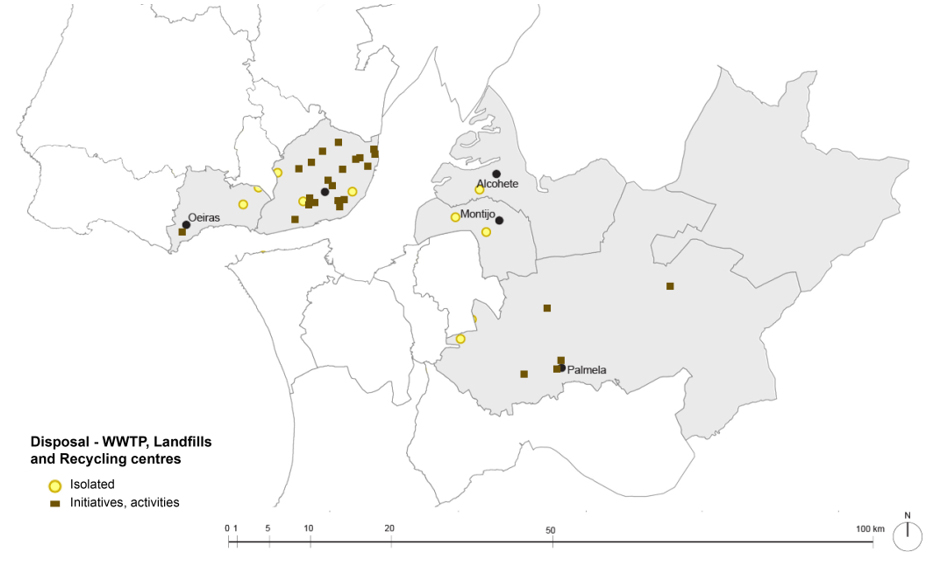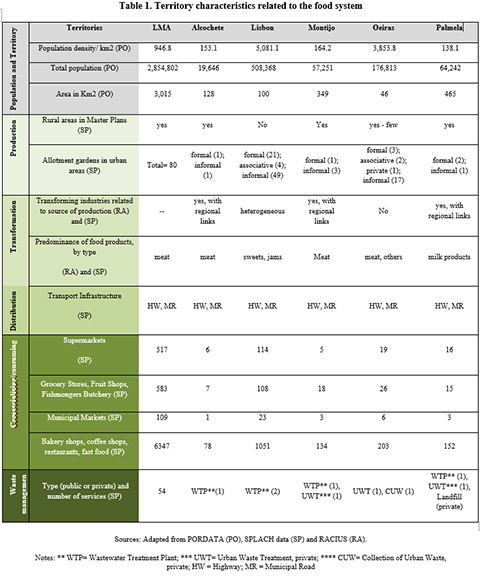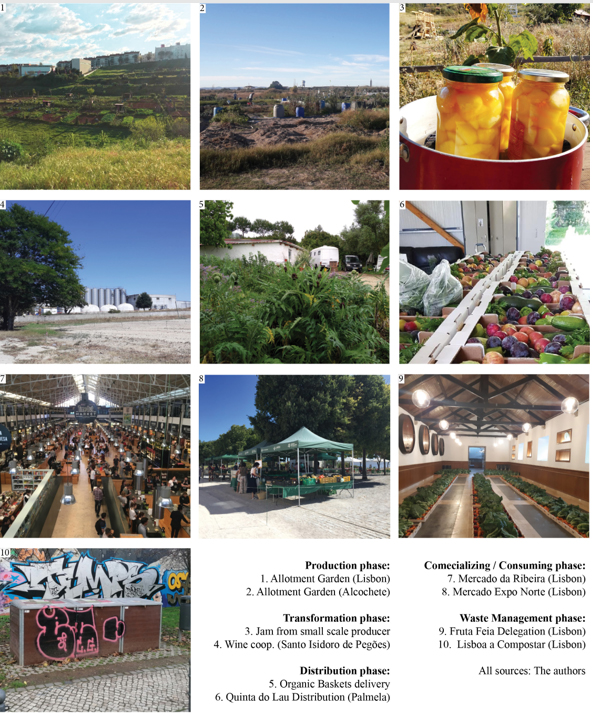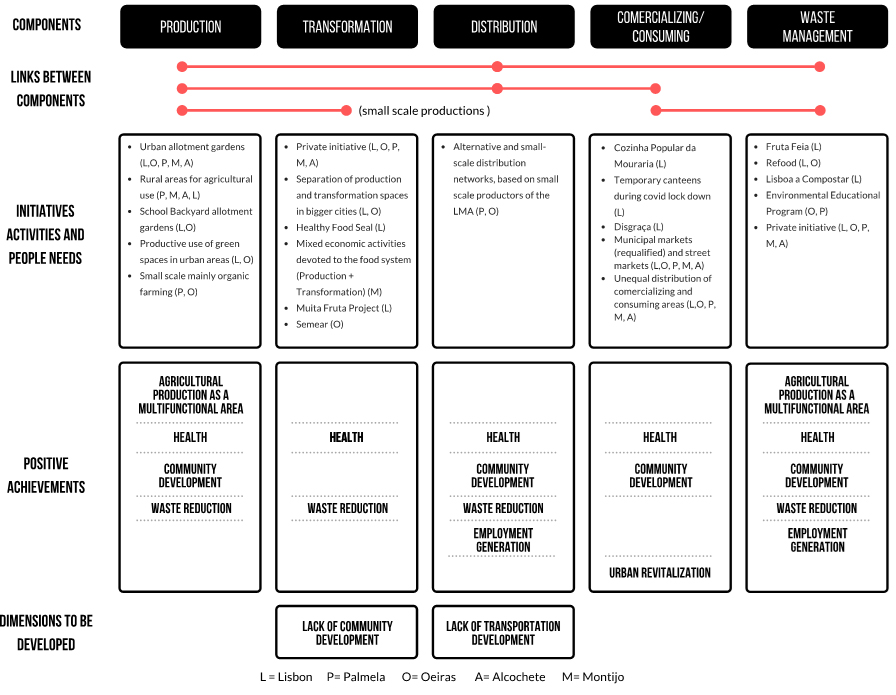1. Introduction
Planning for a sustainable development has conditioned urban planners’ agenda for nearly three decades, in particular since the publication of Our Common Future by the United Nations (1987), usually designated as the ‘Brundtland Report’. Specific areas of attention for planners focus on how to limit energy consumption and pollution, mitigate climate change, protect natural areas and arable land, and provide safe and healthy environments (Naess, 2014). These domains have been mostly conditioned by international treaties, in particular by the Kyoto Protocol, initially adopted in 1997 by the United Nations, but also by the European Union Water Framework directive and the European Landscape Convention, both signed in 2000. Focused on obvious environmental concerns, these documents also concern social, economic and health issues.
The transposition of these European directives to the Portuguese legislation only occurred in 2005, through Law 58/2005 of 29th December for the Water Treaty and Law 4/2005 of 14th February for the Landscape Convention. Transposing these European directives to other scales - metropolitan, municipal and local - constitutes a challenge for which urban planning should contribute to, as it raises questions of how to implement sustainability on a practical level (Williams et al., 2000), precisely when considering its spatial dimension, but also on how it impacts people’s behaviours, lives and health (Hanzl, 2020; Naess 2001; Naess et al., 2008). Urban planning is therefore important to achieve sustainable goals, but it requires the integration of new data and evidence related to environmental performance that eventually impacts the form and the regional entities of cities (Marat-Mendes, 2020; Marcus et al., 2020).
In this context, the food system, because of its transversality to several domains of the urban system, emerges as one of the most challenging and comprehensive systems that support urban planning in addressing sustainable development and climate change problems. Accordingly, the European Commission’s Food 2030 initiative has been pivotal on placing food systems in the urban agenda, while supporting further investigation towards the redesign of food systems and maximizing co-benefits such as food safety, climate change, circularity, the environment or social equity (European Commission, 2019).
But how to reshape such systems? What are their current forms? How to tackle each of those co-benefits? Addressing complex systems inevitably exposes a number of problematics as those related to performance or spatialization for the delivery of the necessary sustainability readings.
The United Nations (UN) 2030 Urban Agenda and its Sustainable Development Goals defined objectives, based on the different dimensions of sustainable development (society, economy and environment), that target the current environmental crisis that we all live in. In fact, according to goal 2 - “Zero Hunger” - the access to nutritious and safe food is considered a fundamental right. Therefore, “supporting sustainable agriculture, empowering small farmers, promoting gender equality, ending rural poverty, ensuring healthy lifestyles, tackling climate change”1 are pressing issues where actions need to be taken in order to guarantee that this goal is achieved. To reach it, the UN has been focusing on protecting the most vulnerable populations from hunger and malnutrition, but also on ensuring small-scale farmers’ productivity, in order to contribute to a more resilient and sustainable food system where genetic diversity of seeds and animals is preserved. Furthermore, goal 11 - “Sustainable Cities and Communities” - mainly focuses on creating new ways of living based on sustainable practices within a city. Consequently, there is a specific target that focuses on the management of solid waste. Moreover, goal 12 - “Responsible Consumption and Production” - brings awareness to current consumption and production rates, whilst promoting the creation of national and even international policy tools that harmonious with nature. Both goals focus on protecting life on Earth (goal 15) by promoting new lifestyles that are symbiotic with nature (United Nations General Assembly, 2015). Additionally, the New Urban Agenda2 - adopted in 2016 by the same organization - was conceived to streamline the different dimensions involved in urban processes, namely, institutions, national governments and local actors, to foster an alignment between the development agenda goals and sustainable urbanization processes and planning. These two documents state the importance of articulating a functioning food system with suitable urban transitions.
However, the connection between food and the city has become an issue where the need for visualization through spatialization has been vehemently requested, in particular from the 2000s onwards, when an evident decoupling of urban planning from the food system was exposed by Pothukuchi and Kaufman (1999, 2000). It is precisely at the spatial dimension of the food system that this paper centres its attention, as it is here that urban planning might identify a possible framework to effectively address the sustainability agenda, in most of the areas of concern to sustainable development.
Research background
How to promote such spatial readings of the food system within a specific territory? Attempts to provide spatialized readings have already been pursued in different historical moments, producing consequent hallmarks for human history. The use of spatial representation supported John Snow, a British doctor to combat the 1854 cholera outbreak in London's Broad Street region and to find the most effective mode of communicating this disease (Snow, 1855), an outbreak utterly related to urban spatial structures and to the contamination of natural resources, such as drinking water.
During the 19th century, in order to feed hungry cities, motivated authorities to address urban agriculture and vegetable gardens as viable solutions, a trend also explored during periods of food shortage in the 20th century. During the major humanitarian crisis of World War I and World War II, most of western cities recognized the importance of urban agriculture to provide the urgent food provision and consequently to develop new policies, while involving the state, political entities and urban citizens participation (Barthel et al., 2013; Lima, 2019; Langthaler, 2013, Viljoen et al., 2005). However, as referred by Barthel et al. (2013) after World War II, these resilient characteristics started to disappear from the urban spectrum, along with the interest to promote public policies in urban agriculture.
During the 21st century, in the aftermath of its first global financial crisis, food shortage re-emerged in Europe. To counteract food deficit, individual citizens turned to urban agriculture for subsistence and opened the way to involve local authorities with urban agriculture and urban planning. In particular, southern European countries, where the practice of urban agriculture in abandoned urban spaces was identified as a mean for fighting the poverty of certain social groups (Abeliotis, 2019; Delgado, 2017; Partalidou, M. & Anthopoulou, T., 2015; Segui et al., 2017).
Recently, several studies have specifically focused on the relationship between natural resources fluxes, such as water, agriculture and territory by making use of cartographic sources to visualize the metabolic functioning of a specific area. In other words, to map the several links and interfaces operating within a territory and the resources necessary to respond to people’s needs and daily life (Marat-Mendes et al., 2015, 2016; Niza et al., 2016). The visualization of metabolic functions emerged as a reaction to the lack of spatial evidences about their implications on the ground. Interestingly, there seems to be a growing interest in visualizing performance and spatial behaviours of the built environment (Pont et al., 2020; Stojanovski et al., 2020). Apparently, these are the same reasons that have guided the study of the food system from a spatialized perspective, in particular, the work led by Kasper et al. (2017), but also by Marat-Mendes et al. (2020) through the work conducted for Project SPLACH - Spatial Planning for Change.
The spatial readings examples retrieved from the past reveal how major societal advances grounded on environmental representations, first concerning earth representation and later the control of sanitary conditions of cities, impacted on planning and health and are, to some extent, encapsulated in the present sustainability agenda. Technological transformations have conditioned cities and territories changes over history and therefore are also important aspects that should be taken into account today. Similarly, changes in behaviours and people’s lives have also implied spatial changes within the built environment. Therefore, because of all these transformations, specific planning instruments and regulations have been formulated to ensure healthy environments and the proper use of available natural resources throughout urban history (Barles, 2007; Fischer-Kowalski, 1998; Gandy, 2004; Serneri, 2007).
Thus, any spatial analysis occurring in a given territory, from a metabolic perspective (Wolman, 1965; Kennedy, Cuddihy and Engel-Yan, 2007; Broto et al., 2012; Dijst et al., 2018), including the food system, emerges as an important exercise to promote further knowledge about the societal issue under analysis. This paper provides a reading of the spatial implications that food-related activities, initiatives and people’s efforts are performing in the Lisbon Metropolitan Area (LMA), to identify how these are challenging urban planning in the implementation of the listed sustainable development goals. Additionally, this article offers some insight into how the recent COVID-19 pandemic impacted the food system of the LMA, while exposing food-related practices which became essential for feeding the city and its region during quarantine, despite the inexistence of proper urban planning practices and policies supporting them.
Kasper et al. (2017) argues that for describing the urban food system one should adopt a systemic and integrated approach, but also to consider it as a fundamental part of the urban system. Other authors agree with this vision (Komisar and Nasr, 2019; Steel, 2008; Viljoen et al., 2005) and our data analysis departs from this allegation as well. This approach to the food system concentrates the attention of planners on its spatial dimensions - production, transformation, distribution, consumption and waste management -, while providing an opportunity to overview the related metabolic processes and the actors involved (Malassis, 1994; Steel, 2008; Kasper et al., 2017). However, not all these components have received identical interest and development. Urban agriculture and commercialization/consumption have been the most explored ones (Viljoen et al., 2005), whereas transformation, distribution and waste management have received less attention.
This challenges the way we describe or understand urban food systems and might help to visualize with greater clarity which linkages and interfaces (specific flows operating within the urban system) are operating at an exact moment. That is precisely the ambition of this research. Therefore, our study applied to a specific territory, the LMA, investigates five case studies - the municipalities of Lisbon, Oeiras, Alcochete, Palmela and Montijo - in order to detail: i) which specific food-related activities, practices and initiatives are operating; ii) what are their urban food processes; iii) which actors are involved; iv) what scales are approached; and v) which linkages or interfaces are involved (inputs and outputs). Our study expands conventional works mostly focused on local bottom-up initiatives (Cabannes, 2012; Banzo, 2015; Pech, et al., 2019), whilst considering initiatives promoted by individual citizens, private, public, public-private and/or governmental partnerships.
This paper is organized into five sections. After this introduction, where the link between urban planning and the food system is explored and the concept of food system is defined and spatialized in terms of its several components, the second section contextualizes LMA, in terms of its geographical and socio-economic characteristics. Complementarily, it introduces the five case studies that supported our spatialization of the food system. The third section describes the data and the methodology upon which the present study rests, whilst the fourth section lists food-related activities, practices, initiatives and people’s needs observed in our research, throughout a reading of their impact on each one of the spatial components of the food system. Finally, we present some conclusions and disclose possible future research questions, including considerations regarding the current pandemic crisis and its consequences for urban planning, in view of the specificities of its food system.
2. The Lisbon Metropolitan Area case studies
The LMA, located in the central Portuguese mainland, is composed by 18 municipalities and covers an area of about 3.015 Km2, which corresponds to 3,3% of the Portuguese territory. The Tagus estuary divides the LMA into two large areas: i) Greater Lisbon (on the northern side of the river), which includes the municipalities of Lisbon, Amadora, Cascais, Loures, Mafra, Odivelas, Oeiras, Sintra and Vila Franca de Xira; and ii) the Setúbal Pensinsula (on the southern side), concentrating ten municipalities that expand concentrically from the estuary: Alcochete, Almada, Barreiro, Moita, Montijo, Palmela, Seixal, Sesimbra and Setúbal.
LMA presents distinct biophysical characteristics, whereas its southern area is clearly differentiated from the northern one due to the Tagus wetlands. Totalizing 325km2, it is considered one of the most important of the European Atlantic Coast, with a unique ecological value that hosts a variety of different species. The extensive plains of the sedimentary basins of the Tagus and Sado rivers produce high biodiversity that co-exists with food-related activities like agriculture, forestry, fishing and salt production (Oliveira, 2016). The preservation of this wetland is both necessary and worrisome in a metropolitan context, due to its proximity to dense urban areas. Presently, 2.863 million residents live in the LMA, which comprises 27% of the Portuguese population (Oliveira, 2016). Their distribution across the LMA territory is unequal, as 63% of the population lives in the Greater Lisbon area.
Each municipality of the LMA is framed by specific biophysical and cultural characteristics, directly affecting their local food systems, but also the region’s. To detail such particularities, our research focused on five municipalities of the LMA: Lisbon, Oeiras, Alcochete, Montijo and Palmela. The first two belong to the Greater Lisbon area, while the other three to the Setúbal Peninsula. Lisbon and Oeiras are representative of high-density municipalities, whereas Palmela, Alcochete and Montijo are low-density municipalities, in terms of concentration of its population. Each one stands for a specific characteristic or dynamic that is relevant for the analysis of the food system and impacts on the several domains with interest for the sustainable development goals: transport, health, land use planning for agriculture and multifunctional area, community development and revitalization, employment generation and waste management. Their geographic, cultural and natural features, as well as their current planning regulations in terms of allowed land uses, officially decreed by the Plano Director Municipal (PDM), here translated as municipal Master Plan, complement a varied selection of situations with interest for the analysis of the food system in the LMA at all its several stages, or spatial components.
Lisbon stands out as the centre of the LMA, with due importance and density. According to its PDML, there is no soil allocated for rural land use, notwithstanding the several allotment gardens that were identified throughout the city. Nevertheless, urban agriculture is allowed along green leisure areas in undeveloped, permeable and planted spaces, on organic soil, and on natural land, either public or private. As residual areas are not necessarily foreseen for this activity3, such as green spaces framing transport infrastructures or fringe belts, several areas in Lisbon still display illegal allotment gardens (Marat-Mendes & Borges, 2019). Lisbon is also the epicentre of food-related bottom-up and institutional initiatives raising a critical mass, a key element for the transformation of the individual and the collective relationship with food.
Oeiras presents urban and socioeconomic similarities to Lisbon: a densely populated municipality, characterized by its high percentage of residents with higher education. Moreover, its location close to Lisbon is strategic to host areas dedicated to industrial and technological parks. Some important industries devoted to food transformation - such as Nestlé - are based here. This municipality foresees, unlike others, land inside urban areas devoted to urban agriculture. Still, Oeiras has worked a path towards urban food production unlike other municipalities of the LMA: since 2019, it controls the ways in which urban agriculture can be developed in the territory, through the legal Allotment Regulation Programme (Regulation number 162/2018). Nonetheless, the quantity of allotment gardens is not higher than its neighbouring municipalities of Lisbon and Cascais.
Alcochete, Montijo and Palmela are examples of municipalities with a high incidence of rural areas and activities, as determined by their master plans. Individually, some specific dynamics and characteristics are worth analysis. Alcochete stands for its salt fields, located along the Tagus estuary, a unique ecological feature that is important for its economic and cultural values. This municipality has had high levels of development since 1998, when Vasco da Gama Bridge was built. Montijo stands for its wine production, an activity that enrols both food production and transformation in the same territory, although fragmented into two areas, one mostly urbanized, and a rural exclave, occupied by large agricultural parcels. Palmela has a strong presence of small-scale businesses devoted to the production of organic fruits and vegetables, wherein its territory is mostly used by agroforest uses.
3. Methods and data collection
To understand how the LMA is being shaped by its food related activities, our work applied a systemic and mixed methodology. A set of qualitative and quantitative data was collected for the five municipalities. The gathered information was retrieved from seven tasks previously conducted by project SPLACH:
a survey of bottom-up food related initiatives, identified on social media platforms and the internet, conducted between July and December 2019;
an extensive survey of urban agriculture informed by City council websites, Google Earth data and onsite visits, between 2018 and 2019;
a survey of existing food baskets produced and distributed in the territory, conducted between July and September 2020;
interviews with urban farmers and food-related business, performed between August and September 2020;
a survey of existing built structures directly impacting the several components of the food system, conducted between April and June 2020;
a photographic survey of the food system of the LMA, conducted between 2018 and 2020;
a critical analysis of the master plans of all municipalities of the LMA regarding sustainability, urban agriculture and food, conducted between May 2018 and July 2018.
For each one of the food system components, analysed in a comparative manner, the information was retrieved according to the SPLACH tasks listed above. It was important to register which activities, initiatives, actors, built forms and land uses are representative of the food system spatiality. Moreover, to what degree these were helpful to counteract specific food needs, for which urban planning is not successfully addressing yet. Therefore, our work expands and entrench information already collected by Oliveira (2014), a biophysical analysis of the food system, but also discloses which present-day food system typologies (spatial forms) are emerging.
It is important to state that each one of the tasks followed specific methodologies. Tasks i, iii and iv followed an ethnographic approach, in order to understand specific particularities found on a micro-scale, and the information was analysed using MAXQDA, a qualitative and mixed methods software programme. Whilst analysing the dynamics of the food basket producers and their relation to the stages of the food system, this analysis allowed for an understanding of socioeconomic flows, which are not visible in a physical or spatial reading. Tasks ii, v, vi and vii were conducted considering graphical purposes, morphological lenses and statistical supports, to produce possible preliminary visualizations of the specific spatial components of the food system and their respective performances. Photographic surveys were used to register built forms and space uses focused on the several components of the food system. Data from emerging food initiatives, including urban agriculture, was gathered and organized using georeferenced mapping supported by Google Earth information, and a photographic record of the existing structures on the ground, to illustrate which initiatives and activities are actually present in the LMA.
4. The spatial components of the LMA’s Food System: an account based on existing initiatives
Production
The first stage of the food system is the most referred one in the LMA municipal master plans, usually referring to agriculture soil use. In particular, the municipalities of Palmela, Oeiras and Montijo give special importance to this sort of land use. There are exceptions, where the food system is however not mentioned. Yet, the need to preserve the agricultural production structure as well as all available green fields is clearly stated (PDM Alcochete, 1997). In denser and urbanized municipalities, like Oeiras, the incorporation of the production stage is indicated to take place through the integration of urban agriculture activities within ecological green structures (PDM Oeiras, 2015).
Lisbon has a different context, without any rural areas, and its PDM does not make any direct references to the food system. Still, urban agriculture is mentioned in its “strategical goals”, which were created in order to promote a sustainable and efficient city design and to provide continuity to its natural systems (PDML, 2012). Before this, urban agriculture activities were officialised in 2007 with the creation of the first municipal allotment gardens. The emergence of this shed light into micro changes that are currently taking place in the densest areas, where a productive use of green spaces is now permitted alongside leisure activities. Our research shows that urban agriculture is an old activity that has persisted unofficially in this territory mostly based on an informal activity (Cabannes and Raposo, 2013 & Castel’Branco et al., 1985). The juxtaposition of the areas dedicated to rural and forestry activities mentioned in the PDM with the SPLACH urban agriculture survey shows not only the land where production activities can take place, but also where they are actually resisting, subsisting and even thriving (Figure 2).
In Alcochete and Montijo, the Samouco Salines integrate an important secondary structural corridor of the Metropolitan Ecological Network. Besides salt extraction, other food production activities also take part of this important ecological structure4.
Transformations on a small scale are occurring in municipalities with rural and urban land uses: Palmela stands out for its large rural area where, according to our findings, a rising number of small-scale organic producers are promoting their sales mostly based on home deliveries to some municipalities of the LMA (where, non-surprisingly, land use is excluded for agricultural purposes). In the densest municipalities several initiatives and activities are promoting environmental awareness and education programmes related to food production. Allotment gardens have been implemented in schools’ backyards in Lisbon and Oeiras, which testify to community involvement, aiming healthier and sustainable diets for its students. School allotment gardens in Oeiras benefited from municipal support, but non-public initiatives have also emerged in school backyards, such as Horta Biológica of Bairro de São Miguel in Lisbon, built on abandoned wastelands.
Oeiras was a pioneer in establishing the municipal allotment gardens programmes. Local authorities regulate the type of products that can be produced and promote the use of organic and pesticide-free urban agriculture. Interestingly, some of these allotments are previous spontaneous agriculture gardens which were converted by local authorities. These programmes contemplate an educational component, based on organic farming techniques, the maintenance of public space, community work, composting and environmental promotion. The goal is to encourage the production and consumption of healthy, sustainable and local food.
Our research identified a high prevalence of informal allotment gardens in Lisbon and Oeiras, where the population, mostly the elders, grow their produce without any public support or regulation. These vegetable gardens are also important to understand the link between urban planning, food system and public health, since they are mostly settled next to low-income residential neighbourhoods or where accessibility from a household to a market/supermarket is difficult or even not available (Delgado, 2017; Hespanhol, 2019; Marat-Mendes et al., 2020; Truninger et al., 2018). They also tend to fulfil an absence, whose nature is impossible to completely grasp, but unlike other initiatives and even the formal vegetable gardens, they can be a reflection of profounder socio-economic problems.
Transformation
The transformation phase of the food system is strategic for the promotion of healthier diets and balanced food programmes and, for that, the intervention of the public sector is crucial in promoting this objective. This is important because nowadays this component lies essentially in the hands of the private sector. A number of initiatives seeking commitments, from food companies to organizations, aimed at product reformulation and the inclusion of nutrient profiles of foods high in fat, sugars and salt is under preparation by the European Commission Farm to Fork Strategy (2020).
In the LMA, food-health related issues in public services are already a matter of concern. The Lisbon City Council, in collaboration with the Portuguese Health Department, promoted the Healthy Food Seal, encouraging the consumption of local and healthy food through the promotion of a Mediterranean diet in schools, non-profits and public canteens (CML and DGS, 2017). Despite the community development informing this initiative, its transposition to a wider territory and population was not yet achieved.
Montijo and Vila Franca de Xira concede the usage of mixed spaces in their PDMs, a vision that bestows a closer articulation between two phases of the food system. Santo Isidro de Pegões, in Montijo, is one of the few examples of villages with mixed economic activities mainly devoted to the food system. It was built in the 1950s and established as a farmer’s colony, where food production and transformation activities work hand in hand. Along with wide rural and productive areas, an Agricultural Cooperative dedicated to wine production is located in the inner village area (Lima, 2016).
Although the geographic link between source of production and place of transformation is steadily disappearing in a global context, for primal activities such as fishing, the location is still decisive for the establishment of an industry. Nowadays, the LMA food system has lost this link between source of production and consumption destination. Alcochete was famous for its salt extraction and codfish drying businesses that persisted on the Tagus coast from the 13th century until the 1970s. Unlike Lisbon, where such industries are now closed, coastal municipalities like Setúbal still maintain their food related fish industries by the water.
According to the Portuguese National Statistical institute, in Alcochete, Montijo and Palmela, there is a strong dominance of agroindustry. In Montijo, 50% of the identified industries are related to meat transformation, in Palmela 50% of the industries are related to milk products, and in Alcochete, where scarce industries transform food, the only identified operating industry is related to meat transformation5. Rather than representing spaces for cattle production, this may be due to the proximity to the nearby regions of Alentejo and Ribatejo, where these activities successfully flourish.
On the contrary, Oeiras and Lisbon display a rather heterogeneous context of industries dedicated to global food transformation. A closer relationship between industry and the place of production has apparently been replaced by the proximity to the road infrastructure, however not spatially restricted to industrial parks, as observed in Figure 3.
Despite their modest growth, the identified initiatives expose how society interest and consciousness for this stage of the food system is still insufficient, considering the sustainability agenda. These initiatives have a potential to positively contribute to public health through food, notably due to the chemical-free processing that most local products go through. Semear6, in Oeiras, is a socially inclusive organization dedicated to producing, transforming and selling chemical-free and organic local food. Similarly, urban agriculture and distribution groups have also devoted themselves to the release of products on the market. However, strict hygienic standards set by national food control authorities significantly constrain its transformation and production. Muita Fruta7 is a Lisbon initiative that collects and offers fruit harvested from the city’s public orchards or single trees to individuals willing to transform them and sell the outcome. Finally, ecological farms and some educational-oriented farms in Lisbon, such as the Faculty of Sciences of the University of Lisbon garden8, create small chains where production is transformed, thus contributing to raise awareness and eventually prevent waste reduction, one of the goals for sustainable development listed above.
Distribution
The third component of the food system, distribution, underpins the urban metabolic flows this paper tries to unveil. According to Alegria (1990) and Salvador (2019), food was unequivocally present in Lisbon for a long time, and food trails were an important function in the definition of the important to structure the city and its main axes. Lisbon’s freight transport has been detached from former railway, port and river transportation modes, so that the only infrastructure devoted nowadays to food transportation is mainly road traffic, apart from airplane.
Distribution is mainly operated by the private sector, and it is working on a large distribution scale. Mercado Abastecedor da Região de Lisboa (MARL), here translated as the Supply Market of the Lisbon Region, is located in Loures. It is a public-private institution financed by all LMA’s municipalities. Fresh products are distributed to retailers that are responsible for delivering it to urban consumers9. Despite its leading importance on a metropolitan scale, other private distributors operate in the LMA and manage warehouses or small industries that import or export global food products.
Our research shows, from a preliminary analysis of the gathered information, how food basket deliveries in the LMA are creating new synergies at the local food systems. A growing sector in the food system, orders from these small businesses increased almost five times during the COVID-19 quarantine10. Despite the lack of support given by public regulations, these entrepreneurs were able to organize themselves in order to guarantee to their old and new clients the delivery of the requested products during the mandatory confinement. Although distributions do not occur in all municipalities, Figure 4 shows where production and distribution happen in the LMA, while showing Palmela as the municipality where most of organic basket production takes places.
Commercialization/Consumption
On a political level, engagement with the commercialization and consuming stage of the food system was almost unperceivable in our critical analysis of the master plans11. In Lisbon, municipal markets were requalified under the expansion of restaurants, in order to increase consumerism. These “new” markets become, through new leisure-oriented uses, anchors for urban revitalization (CML 2016, pp.17-18) Food selling now takes place alongside dense restaurant areas, like in Mercado da Ribeira, explored by TimeOut, having lost some of its former fish selling importance. Unfortunately, less emphasis has been placed in the promotion, enhancement or qualification of traditional food stalls.
Considering food access, Palmela, Alcochete, some rural areas in Montijo, and the hinterland region of Oeiras, present considerable fragilities. These are urbanized areas with scarce or no distribution venues. In Figure 5, commercialization and consuming areas cover mostly urban territories, but also rural spaces, where houses, restaurants, cafes also exist. For each case study, a survey on existing supermarkets, grocery stores, fruit shops, fishmongers, butchers, municipal markets, bakeries, coffee shops, restaurants and fast-food venues highlighted several aspects. In Península de Setúbal, the fact that Montijo has a high population rate and proportionally few supermarkets, municipal markets and grocery shops are prominent. On the contrary, Palmela has one of the highest numbers of supermarkets, even when compared to other municipalities of the LMA. Alcochete stands out for concentrating supermarkets and food stalls mostly inside or on the city’s fringes. In Oeiras, there are several inequalities at a municipal level, where the northern hinterland stands out negatively in terms of food access. This survey also revealed that older and denser urbanized areas are the ones where more of these elements could be found in number and variety.
If, on the one hand, this component covers a wide range of spaces where marketing and consumption activities persist, on the other, there is a whole range of informal sales that are not covered by this survey. This informal element emerges mostly in the urban space, in roadside sales, home deliveries, or even occasional street markets.
Some initiatives found in Lisbon end up promoting a “haven space” where people gather to eat and socialize. In Lisbon, Mouraria’s Popular Kitchen (Cozinha Popular da Mouraria) is responsible for promoting healthy and positive relationships between neighbours who get together around the communal table to cook, share ideas and recipes. It started as a municipal project in 2014, based upon the idea of creating a learning centre focused on exchanging thoughts, cultures and culinary traditions, with a strong component of social intervention (Coelho, 2013).
Recently, the lockdown has unveiled a tissue of self-organized groups that emerged as quick responses to the shortcomings that existed before the pandemic and that the COVID-19 crisis clearly deepened and exposed. Recreativo dos Anjos, Cantina Solidária Temporária and Disgraça emerged as bottom-up initiatives that have incorporated solidary canteens to distribute free meals during the quarantine (Barbedo & Rocha, 2020). Recreativo dos Anjos, a political organization, had already sold meals during the 2008 financial crisis. Such initiatives are even detrimental to understanding the actual crisis, as alerted in a recent governmental study to the fact that, after COVID-19, one person in three is likely to be at food security risk (Direção-Geral da Saúde & Instituto de Saúde Ambiental da Faculdade de Medicina da Universidade de Lisboa, 2020).
Waste management
The waste management component is mainly composed of two ways of reducing waste. EU goals for sustainability, as indicated at the European Commission (2018), account that by 2050 Europe should stand as an emission-free territory, and therefore measures regarding waste management need to be carefully analysed. It is particularly interesting to observe how in the LMA new paths of change are emerging throughout the metropolitan region (Figure 6).
In the 2017 European Commission report on food in cities, Lisbon stood out as a case study for its innovative performance in waste reduction. Surplus food distribution initiatives have been recently launched in Lisbon and disseminated to other metropolitan municipalities: Fruta Feia12 started as a cooperative aimed at combatting market inefficiency by creating an alternative outlet for fruit and vegetables unfit for general consumption standards. The goal was to change consumption patterns, to combat food waste and unnecessary expenditure on the resources used in its production. The cooperative has expanded its delegations to other 4 municipalities of the LMA - Lisboa, Amadora, Almada and Cascais -, and the Metropolitan Region of Porto.
Refood, launched in 2011, targets the elimination of food waste and hunger, involving the whole community in a common cause13. This project now operates in five municipalities in the LMA and outside this area. These two initiatives represent strong contributors to food health through food access, and their organizations are deeply involved in community development. Although Refood mostly relies on voluntary work, Fruta Feia is responsible for creating employment opportunities mostly among young adults. Moreover, Oeiras and Palmela have implemented waste management initiatives with a strong focus on community education and training, through educational programmes to strengthen the environment-food relation and health domains, whilst providing increased knowledge about its production and increased access to nutritious food.
Composting of organic waste was already an activity in practice in some municipal allotment gardens, due to the high value of land fertilizers in the agriculture circuit. Since 2018, Lisbon has been promoting interesting initiatives to encourage the use of public composters by residents that do not own allotment gardens, but who nevertheless produce organic waste in their homes. The pilot-project Lisboa a Compostar14 is still on trial in few civil parishes. These composters will enable kitchen leftovers and other waste generated in food production to be transformed as fertilizer and reused for land compost.
Besides public educational programmes on waste management and resources, other initiatives or activities are promoted by private enterprises. Big scale management projects will integrate a severe change towards a better environment-food relationship. However, this is a difficult task to implement considering that, apart from the Wastewater Treatment Plants, in the LMA this activity is almost entirely run by private actors.
5. Discussion
Considering the importance of food and urban planning, a proper metropolitan strategy is still inexistent in the LMA. It is impossible to identify a public programme focused on providing subsidies for food retailers for the enhancement of the consumption of healthy food, a necessary tool for the promotion of a functioning food system, as defended by Freudenberg, et al. (2018). Still, we can establish that the last decade has triggered a rising interest and entrepreneurship of public and institutional initiatives that increased the dynamics of the food system (Oliveira, 2016; Salvador, 2019), including urban agriculture of informal or formal origin.
Our analysis also revealed in which sense the five spatial components of the food system are intertwined with other urban domains and highlighted specific areas where each component of the food system of the LMA is dominant. Figure 7 presents a spatial link of each component of the LMA food system, while Table 1 provides a systematization of our discussion and highlights important links between components that are created, the dimensions that are reinforced and those that need further development.
The production phase has been strongly enhanced in the urban system due to the integration and officialization of allotment gardens. The acceptance of this activity both in the urban space and inside the urban green leisure and ecological structures has strengthened the link with urban agriculture and the social engagement to this activity, which is vital for the creation of sustainable and resilient food systems. Additionally, the educational character of the initiatives related to urban agriculture is manifold and also an opportunity to support the short food chains and sustainable food systems. On the other hand, municipalities with rural areas also face different struggles. In the last years some have shifted to small-scale organic productions, while facing difficulties with car-distance to Greater Lisbon municipalities.
Food transformation in the LMA has faced a strong decline of its prominent industries and, in the last decades, shifted to a global market logistical dynamic, contributing to foster former industries or to move them to more peripherical areas. That was the case of pre-industrial activities that have become economically impracticable in some urban spaces, such as the codfish salt industries in Alcochete. Although reduced in number and in reach, small-scale initiatives focused on the transformation of food products present significant contributions, remarkably in the reduction of waste and, in some cases, in the enhancement of the nutritious value of products. Ensuring this last goal and the delivery of balanced meals has generally characterized public involvement, yet much remains to be done.
Food distribution is a component where our ethnographic analysis confirmed that new rural-urban networks based on the production, transformation, distribution, consumption and waste management of organic produce has been responsible for empowering and employing a generation sensitive to sustainability. The initiatives display a strong community involvement and a huge effort, particularly from organic farmers, to establish direct links with consumers, based on a mutual concern for shared vulnerabilities, especially during the pandemic. Although the concern for these farmers is practically absent from planning policies, they obstinately operate in the territory, crossing administrative divisions and responding to social and economic demands.
After the COVID-19 pandemic was officially declared by the World Health Organization on March 11, the continuation of their work was fundamental to maintain parts of the food system operating in the LMA. Most importantly, to ensure that production was sold and that their clients, suddenly restrained in their homes for an undetermined period of time, were not left without food provisions, in particular the most vulnerable ones. Although few in number, they represent a strong community engagement to adapt and to face difficulties. In this sense, one could state that community resilience was detrimental to endure both isolation and food provision during the toughest months of the pandemic. These aspects also have a positive impact on the health of city-dwellers, as they contribute to nourish some of the most vulnerable groups of the population in terms of access to balanced meals: the elders and the sick, who were forced to social isolation due to the pandemic.
Our investigation also revealed the possibility of working with alternative distribution networks, however it also foresees a negative overload of road transportation. Thus, shifting to more sustainable transports and ensuring that the components of the food system are systematically planned in order to allow local movements should be a priority in urban planning. Food consumption and commercializing activities were also responsible for urban revitalization in the centre of Lisbon based on an increase in shops selling prepared food rather than vegetables or other food products. Underpinning this particular development of the city is an increase of tourism, which impacted positively the employment rate.
Waste management is one of the aspects where innovative initiatives are most evident in Lisbon and in the LMA in order to effectively reduce waste. This is probably one of the most prominent aspects our study offers as a conclusion, where initiatives are creatively generating local or regional distribution networks based on what used to be considered waste or as a product with no market value. Thus, waste management is productively creating important links with other development goals, especially considering health outcomes. Moreover, since many of the mentioned initiatives are community-organized, this also reflects important involvement and development results for the community.
6. Conclusions
According to Steel (2008), to see the world through food allows us to understand the relationship between allegedly unrelated phenomena. In this paper, we tried to make visible the invisible links which enable food to apparently appear on our plates as if by magic.
The food system and the myriad of components which compose it in the LMA were identified using a mixed-methods approach, which formed a connection between different urban domains, such as transport, health, land use planning for agriculture and multifunctional areas, community development and revitalization, employment generation and waste management. The materialization and mapping of these components revealed its presence, the flows connecting the different stages of the food system and the impact these can have if urban planners take seriously the task of building a sustainable future.
We consider that the already fragile link between planning, the city and the food system was put under test in 2020. COVID-19 was responsible for unveiling the weak food structures operating in the LMA and to show how small initiatives have been asserting themselves on a micro-scale level, facing the already existing problems without proper public recognition or adequate planning.
Our research also shows that food, as a vital component of our urban system, needs to be fully integrated into the political and planning agenda, since its occurrence and positive impacts are already present in the analysed territory. Although it is not possible to immediately transpose our conclusions to other contexts and further research is needed to compare them to different metropolitan areas - especially considering the complexity and the amount of collected information -, our findings show the importance of applying a systemic methodological approach to grasp the multiple variables and the intricacy of the components of the food system in the urban sphere.
Our analysis revealed that the LMA lacks an integrated approach between the transport system and the food system. Continuing the current excessive dependency of the food system on road transportation might result in higher levels of CO2 emissions, with severe impacts on sustainability. There is an opportunity here for urban planning and policies to rethink the current Lisbon Metropolitan food system through an overall integrated transportation plan. As identified in table 1, road infrastructure (highways and municipal roads) is the only one being used as the main distribution channel for the food system.
The LMA presents not only one universal food system, but several rhythms scattered by its 18 municipalities. These fluxes operate on different scales and allow us to better understand the dynamics and the impact of this larger food system on a metropolitan level. The LMA food system is definitely more than the “sum of its parts”. The myriad of initiatives and activities benefits from the physical and social dynamics of each municipality and creates a metabolic flow. However, it is important for each municipality, especially in the southern bank of the river, to ascertain its autonomy in terms of its food system capabilities. On the other hand, on the northern side of Tagus River, most of the productive areas are of an informal nature. Urban planning should definitely support agriculture production and multifunctional areas in this territory. Finally, we conclude that future public policies should be aware of existing local food systems, which are operating in the several municipalities as exposed in this article, to consider the design of a still absent food strategy for the LMA.













